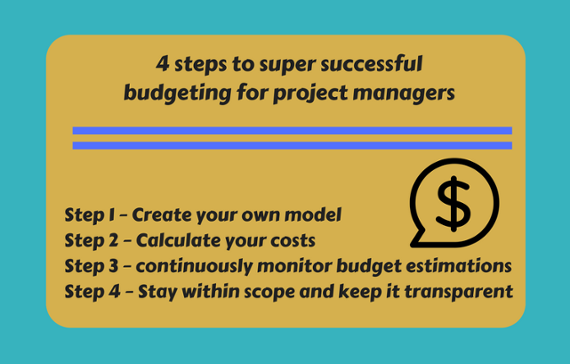What defines a successful project?
Is it timely delivery? Client satisfaction? High quality work? Meeting the original goal and scope? Maybe a combination of all of those?
In the business world of today, every detail matters. As the manager, it’s your job to ensure on-time delivery of the project, make sure that the client is satisfied, keep the quality of the work high and meet the goals of the project.
In short, you have to make the dream come true.
However, there is this one, tiny limitation that keeps popping up in front of all project managers in the world that just drags them back each time they think they are close to the dream – budget. It’s amazing how just one aspect of a project can hinder the pace and success of the whole thing, just by itself.
The thing is, a project will be considered successful, only when all of the above mentioned occurs within a properly set, tight budget. If people had unlimited resources to dedicate to their projects, we would have probably been planting intergalactic seeds on some planet out of our universe by now. Sadly, that’s not how our economy works. If a project goes wildly (or even mildly) over-budget, it starts to represent such a huge risk for the company and all stakeholders that it threatens not only its own existence, but, in some cases, even the whole company’s.
Poor budgeting (and budget management for that matter) is the primary reason why 75% of businesses anticipated their projects to fail during the last several years. There is also the fact that around 40% of projects fail due to the lack of resources, planning and proper activities.
Knowing this, one might think that the more resources and budget you can dedicate to your projects, the more successful your project will be in the end.
Except that’s not the case.
Studies point out that the failure rate for projects with over $1M of budget is 50% higher than those with $350.000. Generally, when there is a big budget, there is also a wider scope of activities that need to be completed for a decently large project to be successful. The thing is that the more resources you have at your disposal, the harder it gets to keep them under tight control. What a paradox don’t you agree?
This is exactly why budgeting is sometimes referred to as “the proxy for project planning”. When you lay down the budget, you basically walk through the entire thing, and can literally see the light at the end of the tunnel.
“Project success heavily relies on proper budgeting and monitoring. It’s crucial for every project, every manager, in every organization.”
So now if you are asking “Ok thanks, but how the hell am I supposed to do that?” then I didn’t waste my time writing this article and you didn’t waste time reading up to this point.
While every project is different and requires a different approach, there are some similarities that all projects share in terms of budgeting. Here are the key steps that you need to take into account closely, when considering budgeting.
Step one – Budgeting | Create your own model of budget
Every successful endeavor in the history of our world shared two common aspects: science and model – the first vehicle model, aircraft model, weapon model, tool model, etc. In our case, science is represented by math and the model needs to be crafted by you and your team. Budgeting is one of those project management aspects that shouldn’t be done alone, simply because it’s close to impossible to do it alone.
To create your own model, don’t feel shy to ask for help from an experienced person or a mentor. Experience is among the most valuable resources you can make use of.
Gather your team together and collect information on their work estimates. Nobody knows how much time a certain amount of work will take better than the person actually doing the work. If you know the ranged estimate, you can reasonably calculate how much budget you will need to make it happen.
Finally, dig into your own company’s data and find similar projects that were completed successfully, and study the approach. The main advantage of this approach is that successful projects get reviewed after they are completed, and key success points are always being outlined. There is always a good amount of information you can gather from past experiences and there is no better place to look for it than your own company files.
Step two – Calculate your costs
Before you do anything else, you need to have a reasonable understanding of how much budget you will need to cover your expenses. Try to include every expense you are dead sure about (like team members, salaries, equipment, travel, software, rent, etc.), calculate them, and compare to the overall budget you have. If your calculations fit under the overall costs, you are doing well. If not, it might be time to go to your boss and present your findings to figure out what to do next.
Keep in mind that there are always going to be “unplanned” or “unexpected” costs (because, well, some shit will definitely happen along the way), even though you might not be able to afford to dedicate budget to that. Instead, try to plan ahead and think of any problems that might hinder your projects (like team members getting sick, missed deadlines, even weather conditions) and have a backup plan to stick to, just in case.

Step three – continuously monitor budget estimations
Budget estimations are just that – estimations. With the unpredictable nature of doing business, scope creep occurrences and unpleasant surprises, your estimations are always subject to change. This is why it’s essential to continuously monitor your budget. Think of it this way – it’s way easier to spot and correct a 10% budget overrun, than a 50% overrun.
Compare the actual budget and costs with the initial estimations and then do the same for anticipated (future) costs at regular intervals. This will help you predict possible future issues and set things right even before those issues occur.
Step four – Stay within scope and keep it transparent
It’s easy to get carried away and put in hours of work into stuff that wasn’t even originally a part of your scope. To counter this, make sure to keep an eye on your project scope and what your team members are working on. Set task and milestone priorities properly and ensure that every person is working on the correct task and putting in the corresponding amount of hours every week.
You might consider using a project management software to easily monitor activities. By the way, PM software been proven to increase the number of projects delivered on time and budget by 44%.
Lastly, remember that proper communication is always at the core of every successful project. Keep everything transparent and let your team members know about every budgeting forecast you make. As mentioned above, budgeting is a team sport – you can’t do it alone. When team members are on the same page, they will have a much easier time accepting any directional changes, be mindful of how many hours they put in for every particular task and even work overtime to ensure you stay on budget.
Some projects are more difficult to scope and budget than others. For instance, you never know what problems will surface when implementing a new software or when. As a result, even the most experienced project managers will be challenged when unexpected events occur. It’s always a matter of how you will deal with those events.
Cost overruns will always happen – you can’t prevent that. But you can always manage them correctly, and in the end, that’ll make all the difference.
Designed by Freepik
Follow us



